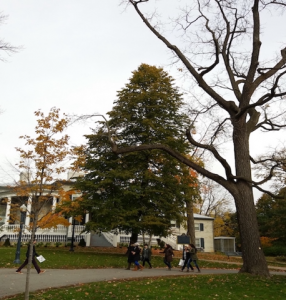Imagine you were an international student, studying at an educational institution in China, with very limited spoken Chinese. How might you feel, trying frantically to understand a completely foreign language; if you were voiceless, unable to communicate something you were desperate to say; if you were also all alone, far away from home?
In the age of globalization, it is common practice for Canadian educational institutions to recruit international ESL students (Zhang & Beck, 2014). The biggest group of international students in Canada is from China (Canadian Bureau for International Education, 2017). But how do Chinese international students actually experience education in Canada? The term “acculturation” refers to the psychological adaptation process that immigrants go through when settling in a new country (Smith & Khawaja, 2011). Cheng and Fox (2008) have defined international students’ academic acculturation as “the dynamic adaptation processes of linguistically and culturally diverse students engaging with the academic study cultures” (p. 309). So how do Chinese international students in Canada experience academic acculturation?
Research has demonstrated that oral English communication capacity is profoundly connected to international ESL students’ academic acculturation in English-speaking countries (Smith & Khawaja, 2011). Research has also demonstrated that Chinese international students tend to have a lower English communication competence than other international students (Li, Chen, & Duanmu, 2010; Wang et al., 2012). Together, these findings suggest that Chinese international students are likely to struggle with academic acculturation due to limited spoken English. However, to this point, very little research has examined these students’ lived academic acculturation experiences.
As an attempt to address this knowledge gap, we designed a musically enhanced narrative inquiry (Bolden, 2017) that involved in-depth arts-informed interviews with six Chinese ESL university students with limited oral English communication capacity. As the name implies, musically enhanced narrative inquiry (MENI) is an arts-based research approach built on narrative inquiry practices that involves artistic exploration utilizing sound and music. Music is used to enhance the representation of data and findings through its potential to capture and communicate nuances of human experience that would otherwise be neglected (Bolden, 2017) and to offer profound possibilities for deepening understanding and connections between participants and audiences (Bolden, 2008; Leavy, 2009). In addition, to compensate for the limitations of verbally based data collection tools in capturing the multidimensionality of lived human experience (Blodgett et al., 2013), and to open up richer communication that embraces the emotional and sensory complexity of participants’ stories (Bagnoli, 2009), we invited participants to use visual artistic representations as a means of communicating their experiences to us. Prior to the interview, participants were asked to choose or create a piece of art to represent some aspect of their academic acculturation experience, and to bring it along to the interview as a prompt for discussion.
Findings
In order to develop understandings from the interview data, we engaged in processes of narrative re-storying (Creswell, 2005), the creation of musically enhanced narrative representations (Bolden, 2017), and general inductive analysis (Thomas, 2006). Our goal in sharing these findings is to provide ESL teachers with a vivid sense of our participants’ experiences.[1]
What are the Academic Acculturation Experiences of Chinese ESL Students with Low Oral English Communication Capacity?
I just sat there, silently. I felt like a transparent person sitting among them. Although they seemed to be right within reach, they were a world apart from me, thousands of miles away. I thought to myself, sitting there, ‘How am I going to live a life like this?’ – Kevin
Our analysis revealed that the academic acculturation stories of the six Chinese ESL students in this study were penetrated with: (a) excitement and shock, (b) frustration and pain, (c) anxiety and inferiority, (d) loneliness and isolation, (e) helplessness and resignation, (f) awakening and regret, and (g) hope and uncertainty.
Art Pieces
We now share what participants told us as they discussed the visual art pieces they chose or created to represent their experiences.
Kandy. When I found myself not able to say what I thought and how I felt, I just felt like that person in The Scream. (As an artistic representation of her experiences, Kandy shared the nightmarish image painted by Edvard Munch (1893) of a skeletal figure with eyes and mouth opened wide in an agonized scream.) Once the Canadian students started to talk, I would think, “Oh my God! Why are they speaking so fast? Oh my God! Why can’t I speak? Oh my God! Why didn’t I say it right? Oh my God! Why?” I felt so constrained and so confined. I could not talk with anyone about those frustrating feelings, and had to keep them all to myself. Sometimes, it was really hard to manage and I felt like screaming. But I couldn’t do it, because I was afraid that the sound would attract attention.

Figure 1. Artistic representation of Selina’s story, created by Selina.
Selina. To me, Canada is a place full of freedom and opportunities, very different from China. I almost felt like I was being released from jail when I came to Canada. However, I couldn’t seize any of those opportunities because I could not communicate in oral English. The falling star in the painting represents the opportunities and also the hope that I want to grasp. If I could grasp just one opportunity, I am sure I could grow and see a bigger world. But without the ability to fluently and efficiently communicate in oral English, I can only watch that star fall in front of me.
Kevin. I chose this picture as the representation of my story because, to me, people are the most important element of life no matter where I am. (Kevin provided a photograph of many people with hands raised in enjoyment and excitement at a stadium music concert.) I was a very social person in China, making friends wherever I went, but in Canada, I was forced to suppress my desire to talk because of my limited spoken English. I could not develop relationships with Canadians, so I always felt alone. I have taken thousands of pictures of the fabulous landscape of Canada, but I chose this picture as the artistic representation of my story, because no matter how fascinating the landscapes were, I always felt something important was missing from the pictures, the people.

Figure 2. Artistic representation of Lisa’s story, photograph taken by Lisa.
Lisa. Studying here in Canada with limited spoken English just feels like that barren tree in the picture. Unlike the other trees around it, it has lost all its leaves, all barren. It’s just like my life here as an international student in a Canadian university—I lost everything I had in China, my social influence, my confidence, my voice, and everything, just like that tree in the picture, barren. Nothing worked after I arrived here because of my inability to communicate, academically or socially.

Figure 3. Artistic representation of Nick’s story, photograph taken by Nick.
Nick. The photo I chose as my narrative representation is a photo I took in the library. I see it as the best description of my life here because I often stay there until midnight or 1 a.m. in the morning before I go back to my dorm. When I walk home in the dark and quiet midnight, I cannot help asking, “Why do I have to spend a supposedly happy weekend in the library like this?” It gets very depressing sometimes. You can almost feel that depressing feeling in the seemingly never-ending stairs in the picture. Every day, I was running up and down those stairs, but unable to read any of the books that I wanted to read because it was already too much for me to handle my academic course content. I really wanted to grab some books from the literature shelves, but I found myself not even able to afford the time to grab the book.
When I was looking down the stairs from the top floor of the library, I felt like I was being suffocated by all the review and preview for my exams and quizzes, desperately trying to catch a breath but to no avail. For a task that took one hour for the Canadian students, I would probably need five hours, because they could understand the lecture content in class and ask questions, while all I could do was take notes and record the lectures to review afterwards.

Figure 4. Artistic representation of Amanda’s story, photo taken by Amanda
Amanda. I chose this picture as the representation of my academic acculturation story in Canada for three reasons. First, I felt somewhat protected by the big tree beside me, resembling the language program protecting me from the actual undergraduate study stress and my parents securing my educational expenses. Then, the moon on the top left corner reminds me of home when I miss home. The picture was taken around the Chinese Mid-Autumn festival. I was homesick. I got very homesick alone abroad when I encountered problems, especially when I got sick. When the doctor told me that I had to have an operation, I called my mom right away. Regardless of anything else, I needed to hear her voice to make me feel safe. Lastly, the light is still there in the picture, just like my hope to learn English well eventually, although I am not sure how yet.
To further illustrate what the students told us, we invite you to listen to a musical composition that serves as a distillation and synthesis of what we learned about the students’ experiences. Please use this link to access the song. The lyrics for the song are in Chinese, with words and phrases drawn directly from the Chinese interview transcripts. We have provided a translation below.
无言的忧伤
The Sound of Silence
独自一人 异国他乡
Alone, treading on a strange land, alone.
无法开口 言伤
Mouth open, silence.
独自一人 异国他乡
Alone, walking in a foreign world, alone.
热闹非凡 旁观
Faces smiling, silence.
你可曾体会 那无言的忧伤
Have you ever felt that sadness without the words?
你可曾听见 那无声的呐喊
Have you ever heard that mad scream in silence?
我翻山越岭 漂洋过海 难道只为 这繁花似锦下的孤单?
Sitting inside the room,
I asked myself, alone.
“Did I come, across the mountains and the sea,
thousands of miles away from home,
to be alone?”
独自一人 异国他乡
Alone, walking on a strange road, alone
无法开口 言伤
Autumn leaves falling, barren.
独自一人 异国他乡
Alone, walking in the lamplight, alone.
落叶飞扬 影孤长
Midnight shadows swinging, soundless.
你可否明白 那无言的绝望
Have you ever felt that despair without words to compare?
你可否感受 那无声的惊慌
Have you ever felt that trembling running through the vein?
我翻山越岭 漂洋过海 难道只为 这雪花飘零下的冷淡?
Standing under the moon,
I asked myself, alone.
“Did I come,
across the mountains and the sea,
thousands of miles away from home,
to be alone?”
你是否明白?
Do you understand?
(Narration with chords)
我悔恨的是 那蹉跎的美好光阴
Regrets. Time wasted on useless things.
我愤恨的是 那南辕北辙的苦行
Rage. Endeavours exerted in vain.
愿胸怀世界的你
听到我的声音
How I wish,
you who have the minds to see the worlds,
will hear my voice,
and walk a different path.
蓦然回首时
不再像我一样
独自一人 异国他乡
无法开口 言伤
So when you go across the ocean to see the world of your dream,
it will be like your dream, unlike me,
walking in a foreign world, alone, in the sound of silence.
For access to the other seven themed musical representations and full stories, please use this link.
Conclusion
ESL educators need to be aware of the particular challenges international ESL students with limited oral communication capacity face. Our research highlighted the intense emotional strain that our participants experienced as a direct result of their inability to communicate orally; they experienced frustration, anxiety, inferiority, loneliness, and helplessness. Even with high capacity in listening, reading, and writing, international students with limited oral language can experience severe challenges. Our research findings emphasize the need for English language teaching to focus on more than just listening, reading, and writing; speaking is crucially important. Through helping learners to develop this capacity, ESL teachers empower their students to connect.
[1] Prior to conducting this research, we received ethics clearance from the Queen’s University General Research Ethics Board and informed consent from all six participants for dissemination of their stories and provided art presentations. In order to protect the privacy of our participants, any use of the data conceals all identifying information such as names and locations. Pseudonyms were assigned to all participants.
References
Bagnoli, A. (2009). Beyond the standard interview: The use of graphic elicitation and arts-based methods. Qualitative Research, 9, 547–570.
Blodgett, A. T., Coholic, D. A., Schinke, R. J., McGannon, K. R., Peltier, D., & Pheasant, C. (2013). Moving beyond words: Exploring the use of an arts-based method in aboriginal community sport research. Qualitative Research in Sport, Exercise and Health, 5, 312–331.
Bolden, B. (2008). Suds and Stan: Musically enhanced research. Journal of Creative Arts in Education, 8(1). Retrieved from http://www.jcae.ca/08-01/bolden.html
Bolden, B. (2017). Music as method: Musically enhanced narrative inquiry. International Journal of Education & the Arts, 18(9), 1–19.
Canadian Bureau for International Education (CBIE). (2017). Facts and figures:
Canada’s performance and potential in international education. Retrieved from http://cbie.ca/media/facts-and-figures/
Cheng, L. & Fox, J. (2008). Towards a better understanding of academic acculturation: Second language students in Canadian universities. Canadian Modern Language Review/ La Revue Canadienne Des Langues Vivantes, 65, 307–333.
Creswell, J. W. (2005). Educational research: Planning, conducting, and evaluating quantitative. New Jersey, NJ: Upper Saddle River.
Leavy, P. (2015). Method meets art: Arts-based research practice. New York, NY: Guilford.
Smith, R. A. & Khawaja, N. G. (2011). A review of the acculturation experiences of international students. International Journal of Intercultural Relations, 35, 699–713.
Thomas, D. (2006). A general inductive approach for analyzing qualitative evaluation data. American Journal of Evaluation, 27, 237–246.
Wang, K. T., Heppner, P. P., Fu, C., Zhao, R., Li, F., & Chuang, C. (2012). Profiles of acculturative adjustment patterns among Chinese international students. Journal of Counseling Psychology, 59(3), 424–436.
Zhang, Z. & Beck, K. (2014) I came, but I’m lost: Learning stories of three Chinese international students in Canada. Comparative and International Education / Éducation Comparée et Internationale, 43(2), 1–14.
Deyu (Cindy) Xing, ESL educator and researcher, is a recent M.Ed. graduate in the Faculty of Education at Queen’s University, Canada. She earned both her B.Ec. and B.A. at Beijing Foreign Studies University in China. Prior to coming to Queen’s, she worked in various educational settings, from language education centers to universities. Her current research interests include international students’ academic acculturation, second language acquisition, arts-informed research, at-risk learners, and student success.
Dr. Benjamin Bolden, music educator and composer, is an associate professor and the UNESCO Chair of Arts and Learning in the Faculty of Education at Queen’s University, Canada. His research interests include arts education systems around the world, the learning and teaching of composing, creativity, arts-based research, pre-service music teacher education, teacher knowledge, and teachers’ professional learning. As a teacher, Ben has worked with pre-school, elementary, secondary, and university students in Canada, England, and Taiwan. Ben is an associate composer of the Canadian Music Centre and his compositions have been performed by a variety of professional and amateur performing ensembles. In 2016 he won the Choral Canada Competition for Choral Writing. Ben was editor of the Canadian Music Educator, journal of the Canadian Music Educators’ Association/L’Association canadienne des musiciens éducateurs, from 2007-2014. He is the proud father of three rascally boys.

Great depiction of the lonliness and emotional stress experienced by the students with limited language competence and away from their home.